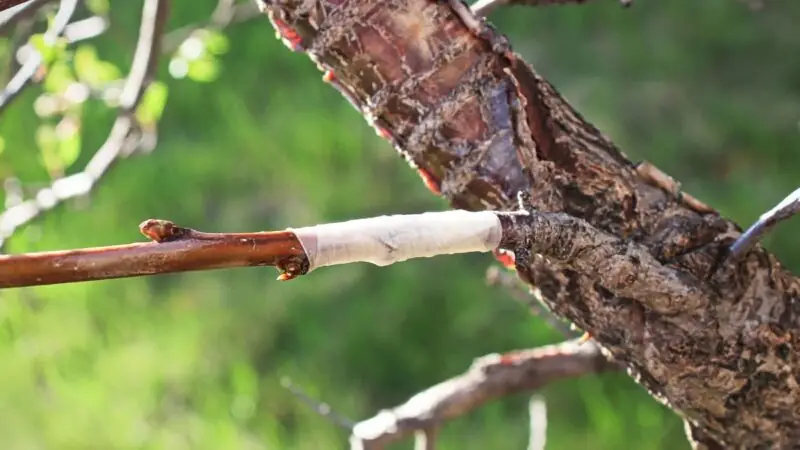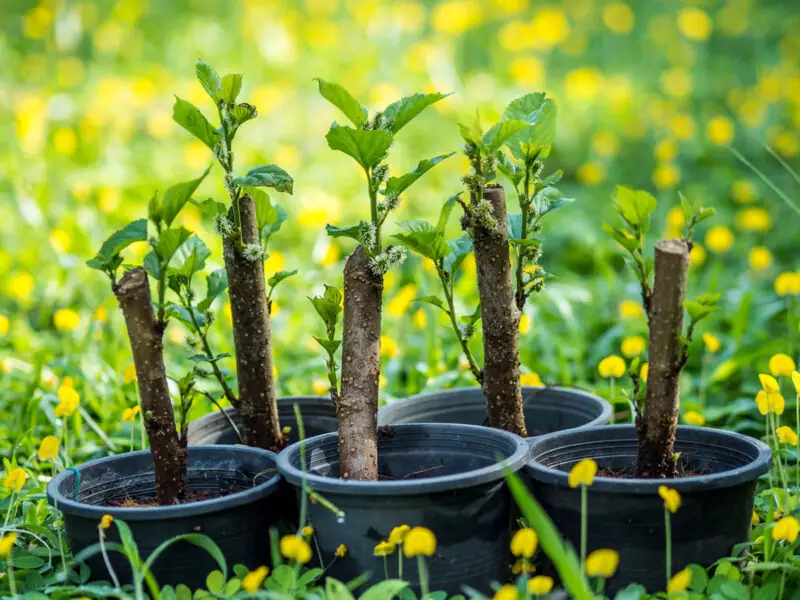Grafting Propagation Stone Fruit Trees: Mastering Grafting and Budding Techniques in Your Nursery

Welcome to our comprehensive guide on grafting propagation, an age-old practice and a gardener’s secret weapon! We’ll delve into this fascinating world, shedding light on key features and practical applications, all delivered in a light, engaging tone.
Overview of Grafting Propagation
Grafting propagation is like an intricate botanical dance, taking center stage in horticultural practice. It’s the act of surgically joining two plants – a scion, or the upper part bearing the desirable traits, with a rootstock, the lower part offering hardiness and vigor. This blend births a new plant bearing the best of both parents. Think of grafting as a plant superhero factory, creating hybrids suited to specific needs.
This technique is a game-changer for fruit tree propagation. You’ve probably relished a juicy apple from a grafted tree without even knowing it. But the art of grafting isn’t confined to commercial orchards. It’s equally popular among home gardeners, budding enthusiasts, and hobbyists, offering endless possibilities in creating an impressive variety of plants.
The Significance of Grafting and Budding in Propagation
Grafting and budding open the doors to a world of exciting horticultural possibilities. They empower us to grow better, stronger, more beautiful plants. Imagine merging the delicious fruit of an exotic apple tree that struggles in your climate with a hardy local variety. The result? A tree producing your favorite apples right in your backyard, unfazed by the local weather.
In addition to this, grafting and budding are champions of plant conservation. They allow us to preserve heritage varieties or those tricky to propagate through seeds. So, these techniques don’t just cultivate plants; they help sustain biodiversity too.
Understanding Grafting Basics
What is a Graft?
In the simplest terms, a graft is the marriage of two plants. In this beautiful union, the scion (cut from the desired plant) is joined with the rootstock (the lower part of another plant). This process of grafting is akin to a plant’s version of a transplant, fusing two separate plant parts to function as a single entity.
A successful graft results in a new plant combining the strength and resilience of the rootstock with the unique characteristics of the scion. It’s like crafting your own plant recipe, mixing and matching flavors for that perfect blend.
Importance of Scion and Rootstock in Grafting
Scion and rootstock are the stars of the grafting show. The scion, chosen for its desired traits, maintains its genetic identity when grafted onto the rootstock. The rootstock, although often underappreciated, lays the foundation for the new plant, providing vigour, disease resistance, and climatic adaptability.
Their compatibility, both physical and biological, is critical for a successful graft. Typically, the scion and rootstock need to be closely related (often from the same genus), ensuring that the graft union heals and the plants grow together.
Difference Between Grafting and Budding
While both grafting and budding are grafting propagation techniques, they are different in their approach. Grafting usually uses a piece of stem containing multiple buds as the scion, while budding involves grafting a single bud onto the rootstock. Variations like summer budding and June budding take place during the growing season, while dormant budding happens during early spring when plants are still fully turgid.
Grafting Technique
An Overview of Grafting Tools
Successful grafting calls for a good set of tools. A sharp, clean grafting knife or budding knife is essential for making smooth cuts, reducing damage to plant tissues. Grafting tape and wax come in handy for wrapping and sealing the graft, promoting healing, and preventing moisture loss. You might also need a cleft grafting tool for specific types of grafts. And always remember, the cut is made to fit the type of graft. These tools can be sourced from various grafting supply resources, both online and in-store.
Basic Steps in Grafting
Grafting might seem daunting, but fear not! It’s just a simple method that needs a bit of practice. It starts with choosing the right rootstock and scion. Once you have these, you cut into the wood of the rootstock to create a place for the scion. The scion should be cut to match the cut on the stock. Then, the scion is inserted into the rootstock so that the cambium of the scion (a thin layer between the bark and wood) matches the cambium of the rootstock.
The graft is then secured with grafting tape or a rubber budding strip and sealed with grafting wax or paint to prevent it from drying out. A plastic bag may be used to maintain humidity. In the case of a whip and tongue graft, or cleft graft, additional cuts are made to increase contact between the cambium layers of the two plants.
Role of the Bark in Grafting
The bark plays an essential role in grafting. It’s the outer protective layer of a plant’s stem, housing the cambium, a vital player in grafting propagation. The cambium is the magical layer responsible for plant growth, generating new bark and wood. It is this cambium that the scion and stock must connect to unite into one plant.
Types of Grafts
Cleft Graft
A cleft graft is a type of graft ideal for larger stock, typically an inch in diameter or more. The process involves grafting a scion onto a rootstock by cleaving or splitting it and inserting the scion into the cleft. This grafting method is often used with fruit trees like peaches, plums, and apples and can result in very sturdy and productive plants.
Understanding the Cleft Graft Technique
First, a cut at the top of the rootstock is made and split open. The scion, typically containing two to three buds, is shaped into a wedge and inserted into the cleft. The cambium layers of the scion and the rootstock are aligned for successful growth. The graft is then sealed and bound to prevent moisture loss.
When to Use a Cleft Graft
Cleft grafting is typically done during early spring, when both the rootstock and the scion are dormant. This gives the graft time to heal before the growing season when the plant’s energy is focused on developing new growth.
Chip Budding
Chip budding is a technique where a bud is removed from the desired plant (the scion) with a small chip of wood attached. This bud ‘chip’ is then inserted into a matching cut on the rootstock and secured.
What is Chip Budding?
Chip budding involves the precise cutting of a bud from a scion along with a small piece of bark and wood. A matching cut is made in the rootstock, and the bud ‘chip’ is fitted in place. The connection is then wrapped and left to heal. If successful, the new bud will grow into a shoot, drawing nutrients from the rootstock.
Appropriate Situations for Chip Budding
Chip budding is typically done in late summer when the bark of the plants can be easily separated from the wood, making it easy to extract and insert the bud ‘chip’. This technique is frequently used in the propagation of roses and some stone fruits.
Bench Grafting
Bench grafting is a practice of grafting where the operation takes place indoors, typically on a ‘bench’, hence the name. This technique is used when rootstock and scion are dormant, usually in late winter or early spring. Bench grafting is beneficial for grafting many plants together at once and can be done with a variety of graft types.
Bench Grafting Process
The bench grafting process starts with a rootstock and scion of a similar diameter. After cutting both the rootstock and scion, typically with a whip graft or a whip and tongue graft, they are joined. It’s crucial to align the cambium of both for successful grafting. The grafting is often sealed with wax or grafting paint and secured with grafting tape or budding rubber.
Advantages of Bench Grafting
Bench grafting is generally a great way to start seedlings, particularly for fruit trees. It allows for the propagation of many plants in a small space and the grafting takes place under controlled conditions, which tends to yield high success rates. The resulting plants can be grown on the bench until they’re ready to be transplanted outdoors.
Grafting Supply Resources

Essential Grafting Tools
Some basic types of tools you’ll need for grafting include a grafting knife for making precise cuts on the scion and rootstock, grafting tape or budding rubber to secure the graft, and grafting wax or paint to seal the graft and prevent moisture loss. Other tools like a cleft grafting tool, a budding knife for budding techniques, or a grafting chisel for larger scale operations could also come in handy.
Where to Find Quality Grafting Supplies
There are many places where grafting supplies can be found. Nurseries often stock a range of grafting tools, and there are various online resources too. Websites specializing in gardening supplies or plant propagation techniques usually have a section dedicated to grafting and budding require specific tools.
Propagation through Grafting or Budding
Process of Grafting and Budding for Propagation
Both grafting and budding are propagated by inserting a part of one plant (scion or bud) into or onto another plant (rootstock). While grafting involves the union of a scion and a rootstock, budding involves the insertion of a single bud. Grafting is performed when both the scion and rootstock are dormant, typically in early spring. Budding, however, is done when the plants are still fully turgid, usually in summer.
Factors for a Successful Graft
Several factors can influence the success of a graft. The compatibility of the rootstock and scion, the cleanliness of the cut surface, the alignment of the cambium layers, and the proper sealing and binding of the graft union are all crucial. Additionally, environmental conditions must be right – cool and the plants should be well-watered.
How to Encourage a Dormant Graft
A dormant graft needs the right conditions to ‘wake up’ and start growing. After grafting, the graft union is typically covered to maintain humidity. It’s also important to keep the graft at a stable temperature. When the growing season begins, the graft should start to show signs of life.
Frequently Asked Questions (FAQs)
Choosing the right rootstock for grafting is key. The rootstock should be disease-resistant, adapted to the soil and climate, and compatible with the chosen scion. Budding requires a compatible rootstock too, which also matches the vigor and growth habit of the scion.
While grafting is used widely, it’s not suitable for all plants. Some plants can easily be grafted, like fruit trees, roses, and some vegetables, while others are not amenable to this technique. Always do research before starting the grafting operation.
There are various types of budding techniques, including T-budding, chip budding, and patch budding. The choice of technique depends on the type of plants involved and the time of year.
The healing time for a graft can vary depending on the type of graft, the species of plants, and the environmental conditions. However, most grafts take several weeks to a few months to heal fully.
In most cases, grafting is successful between plants that are closely related. While some exceptions exist, grafting between different species often results in failure due to the plants’ inability to synchronize their growth and healing processes.
Conclusion
To wrap things up, grafting propagation is a fascinating field that blends art with science. We delved into its significance, understanding the core concepts like the role of a scion and rootstock, and the difference between grafting and budding. We discussed the various tools and techniques used in grafting, including cleft graft, chip budding, and bench grafting.
We also covered the importance of choosing the right tools and where to find them, and discussed some key points for successful grafting, including the importance of aligning the cambium layers and providing the right conditions for grafting to flourish.